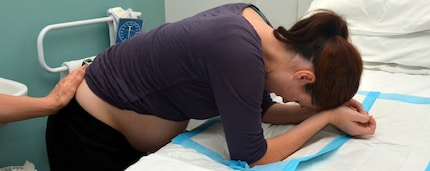
Background information
To breastfeed or not!
by Chantal Häusler-Naunheim

Giving birth is one of the most intense, emotional and impressive experiences in a woman's life. Regardless of whether it is positive or negative, it is a turning point in life and turns it upside down. This was also the case for Fabienne and Peter. I, Norina Wartmann, am a midwife and am telling you the story of this couple. They are expecting their first child soon and their emotions are on a rollercoaster.
In my first report "Yay, we're pregnant or help our world is upside down?" I introduced you to Fabienne and Peter. The couple decided to give birth in hospital. I am their attending midwife and have been accompanying them on this fantastic adventure since the start of their pregnancy. Last time in the report "Oh, my waters have broken!" the birth of their first child was imminent. And now the time has come, here we go!
About the background: [[marketingpage:4389]] [[marketingpage:4514]]
It hasn't been five minutes since we said goodbye when my phone rings. It's Fabienne. "My waters have just broken, I really heard it pop and now everything is wet!" she says with a laugh.
I'm very happy about this phone. I thought that the baby would be on its way soon, but I didn't realise it would be so soon. I want to know from Fabienne what colour the amniotic fluid is and whether she can feel the baby well. "The amniotic fluid is clear and the pH strip you left me is deep blue. I can feel the baby. Should I call Peter? He's still in the mountains. Or will tomorrow morning be enough?" asks Fabienne.
Fabienne will try to get some more rest. If things stay calm on the abdominal front during the night, I'll visit her in the morning for a check-up. The amniotic fluid smells sweet, is alkaline and has a pH of around 7. Especially at the end of pregnancy, the body produces more mucus and it is difficult to control the bladder. If you are unsure whether it is mucus or amniotic fluid, you can check this yourself with a pH strip. If in doubt, contact your doctor or midwife.

Fabienne got some sleep and Peter is back. Unfortunately, the planned skiing holiday didn't work out. That's the way it is with children, they turn the world upside down before they even see it. I check the baby's heartbeat and take blood samples from Fabienne to check her inflammation levels. It has now been 12 hours since the rupture of the membranes.
"How long can we wait now? Is the baby on dry land now?" Peter wants to know.
As long as the amniotic sac is intact, the baby is in a sterile environment. If the amniotic sac is open, germs can rise from the vagina and cause an infection. This is why we check the inflammation levels in the blood every 12 hours. The amniotic fluid is constantly replenished, so the baby is not left out to dry. If all the values are good, we can wait 24 hours. The birth then often starts all by itself. I advise both of them to rest a little and go for a walk later.
"I have another appointment with an osteopath at 4pm. I'd like to go because it's really good for me. Is that okay?" asks Fabienne.
There's nothing wrong with an appointment with an osteopath. On the contrary, they often work wonders. Especially if you have low back pain. But they can also straighten the pelvis to put the baby in the best possible position for the birth.
On the phone, Fabienne tells me that osteopathy has done her good and that she has had more contractions since then. She is also taking teaspoons of castor oil to stimulate contractions.
It is now evening, 24 hours after the rupture of the membranes. Peter and Fabienne are still at home. I visit them one more time for a check-up. The baby is unimpressed and has great heart sounds. The inflammation levels are stable and Fabienne's contractions are slowly getting stronger and more regular. She feels completely at ease at home and enjoys the peace and quiet. I suspect that Fabienne will go into labour during the night. Together we decide to stay at home for the time being, where she feels comfortable and can let herself go. If nothing happens in the evening, Fabienne will go to hospital in the morning for induction.
It's half past two in the morning when the phone rings. It's Peter. Fabienne is now having regular contractions that are lasting longer and they are going to the hospital. As I'm her attending midwife, I'm also making the journey.

It is recommended that a woman should go to hospital if she has regular contractions every five minutes that last for over an hour. Personally, I always advise women to rely on their gut feeling. You may have contractions every two to three minutes, but they are still very short and you feel fine at home. Then it's definitely not the right time yet. If a woman no longer feels comfortable at home, she should go to hospital. Regular contractions are required for a birth and the labour demands full concentration from the expectant mother.
Half an hour later, we meet at the hospital. Fabienne has changed since my last visit. She is calmer, focused and breathing through her contractions. I listen to the baby's heartbeat on the CTG and feel her cervix a little later. It is 1-2cm open and feels quite tight. As this is only the beginning of the labour, Fabienne tries to rest a little longer with the help of antispasmodic suppositories, a warm compress and a herbal sleeping cocktail. But Fabienne vomits. Resting no longer works. She adopts various positions and Peter massages her back. Massages, heat, movement and the breathing technique of "sounding" can help her relax and deal with the contractions.
Even three hours later, the cervix has not opened any further despite strong contractions. The cervix feels very tight and the baby's head is pushing down hard. This is very frustrating for Fabienne. She doubts whether she will make it through this and naturally wonders how much longer she will have the strength to cope with these contractions. Fabienne immerses herself in the warm water of the birthing tub. I give her an infusion so that her body has enough fluid. The infusion contains bryophyllum/conchae (herbal remedy), which gives longer breaks and helps Fabienne to come round. She is then given an infusion of Buscopan (antispasmodic) and Chamomilla globules.
I have to promise Fabienne that she will have an epidural if she can't continue after the infusion. She curses while Peter struggles with his emotions, but still lovingly looks after Fabienne and makes sure that she lets everything go and relaxes during the breaks in her contractions. We sound, let go and use the valuable breaks to recharge our batteries.
How to deal with contractions/pain
I examine Fabienne and am very surprised and at the same time relieved that her cervix is almost completely open. I motivate her and tell her that it will be easier when her cervix is fully open, i.e. the full 10 cm. She takes some glucose and tea with honey to keep her strength up. The transition phase between 8-10cm) is part of the birth phase, in which women don't want more and reach their limits. It's like when you hike to the top of a mountain and feel like you'll never reach the top.
Six hours have now passed since arriving at the hospital. The cervix is fully dilated and Fabienne can feel the baby slipping deeper, feels pressure on her rectum and pushes the baby towards her pelvis. Peter can no longer hold back his tears. Fabienne looks at him and says very clearly: "The contractions now are much less severe than before! I'm feeling fine! Now I can finally do something."

It is often difficult for a man to watch his wife give birth, to see her reach her limits and not be able to do anything. But even if the man cannot actively do anything, it is important that he is there. Because he can motivate, help breathe, massage, make sure that the woman keeps drinking something. Simply be there and accept everything your wife needs at that moment and give it to her. Be it closeness and touch or distance.
And very important: look at yourself! If you're hungry as a man, eat something. If you are overwhelmed by your feelings, go out for a quick breath of fresh air. If you have the feeling that your wife needs a painkiller, ask yourself whether she really needs one or whether you are the one who can't take it. If you have a full bladder, go for a pee. Because if you are tense, this tension may be transferred to your wife. But be there and believe in your wife. This helps more than you can imagine!
Once the cervix is fully open, it usually takes another two to three hours for the baby to find its way through the birth canal. It is millimetre work.
Fabienne adopts various positions. She squats low, on her side, in a quadruped position, stands up. The child slowly makes its way through the channel.
You make your first cry in the sunshine and at the stroke of 12 o'clock! You are fit, rosy and, at 56cm, an incredibly long baby. And for being born 16 days before your due date, you weigh a proud 3900g. You are lovingly greeted and marvelled at by your parents. And your mum is incredibly proud to have given birth to such a big baby. Then I lay you naked on your dad's upper body. There you enjoy extensive bonding* with your dad and cuddle with him. Unfortunately, your mum loses a lot of blood and needs a short general anaesthetic as a piece of the placenta has remained inside.
Everything is well over. The little family is doing well and enjoying their time together. Everyone is relieved.
Despite the short separation from your mum, you are sucking hard on the breast and won't let go of her any time soon.
Happy birthday little, big, long man!
In the next part, breastfeeding counsellor Chantal Häusler will tell you how Peter and Fabienne are doing after the birth.
How they are settling into "parenthood" and what you can do if you have a little less milk and your baby is only gaining weight slowly.
*Bonding is the first bond between the parents and the newborn. During this first contact, everyone gets to know each other and grows together. Lots of skin-to-skin contact promotes the mother-father-child relationship. The contact makes breastfeeding easier and gives the newborn a sense of security and safety in the new, unknown world.
Midwife for 10 years and this with absolute passion. It is close to my heart that women are allowed to give birth in dignity, self-determined, protected and in their own rhythm. Creating a space where parents can welcome their children into this world undisturbed and lovingly is one of my greatest concerns. This requires a lot of flexibility. Births cannot be planned and neither can my life. The phone rings and I'm off... for how long, nobody knows exactly. Even a mother of two wonderful children, married to an understanding man and surrounded by many loving people. Without this fantastic environment and reliable help, my life would be different. <br><a href="http://hebammen-begleitung.ch/" target="_blank">www.hebammen-begleitung.ch</a>
Interesting facts about products, behind-the-scenes looks at manufacturers and deep-dives on interesting people.
Show all